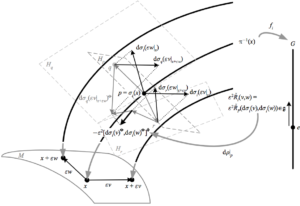

For the star pattern either 3 or 1 ridge line pass through the umbilic, for the monstar and lemon only one ridge passes through. The ridge curves pass through the umbilics. These ridge points form curves on the surface called ridges. When a line of curvature has a local extremum of the same principal curvature then the curve has a ridge point. In these figures, the red curves are the lines of curvature for one family of principal directions, and the blue curves for the other. Configurations of lines of curvature near umbilics.Gaston Darboux, the first to make a systematic study in Vol. These points are also called Darbouxian Umbilics (D 1, D 2, D 3) in honor of In the vicinity of an umbilic the lines of curvature typically form one of three configurations star, lemon and monstar (derived from lemon-star). There will be two lines of curvature through each non-umbilic point and the lines will cross at right angles. The lines of curvature or curvature lines are curves which are always tangent to a principal direction (they are integral curves for the principal direction fields). The monkey saddle is one surface with an isolated flat umbilic. A generic surface will not contain flat umbilic points. At flat umbilic points both principal curvatures are zero.Parabolic points generally lie in a curve separating elliptical and hyperbolic regions. At parabolic points, one of the principal curvatures is zero.At hyperbolic points, the principal curvatures have opposite signs, and the surface will be locally saddle shaped.These typically occur in isolated points. At umbilic points, both principal curvatures are equal and every tangent vector can be considered a principal direction.At elliptical points, both principal curvatures have the same sign, and the surface is locally convex.Let M be a surface in Euclidean space with second fundamental form \displaystyle. For a minimal surface, the mean curvature is zero at every point. If at least one of the principal curvatures is zero at every point, then the Gaussian curvature will be 0 and the surface is a developable surface. The product k 1 k 2 of the two principal curvatures is the Gaussian curvature, K, and the average ( k 1 + k 2)/2 is the mean curvature, H. A systematic analysis of the principal curvatures and principal directions was undertaken by Gaston Darboux, using Darboux frames. From a modern perspective, this theorem follows from the spectral theorem because these directions are as the principal axes of a symmetric tensor-the second fundamental form. The directions in the normal plane where the curvature takes its maximum and minimum values are always perpendicular, if k 1 does not equal k 2, a result of Euler (1760), and are called principal directions. The curvature is taken to be positive if the curve turns in the same direction as the surface's chosen normal, and otherwise negative. Here the curvature of a curve is by definition the reciprocal of the radius of the osculating circle. The principal curvatures at p, denoted k 1 and k 2, are the maximum and minimum values of this curvature. This curve will in general have different curvatures for different normal planes at p. A normal plane at p is one that contains the normal vector, and will therefore also contain a unique direction tangent to the surface and cut the surface in a plane curve, called normal section. 3 Classification of points on a surfaceĪt each point p of a differentiable surface in 3-dimensional Euclidean space one may choose a unit normal vector.


 0 kommentar(er)
0 kommentar(er)
